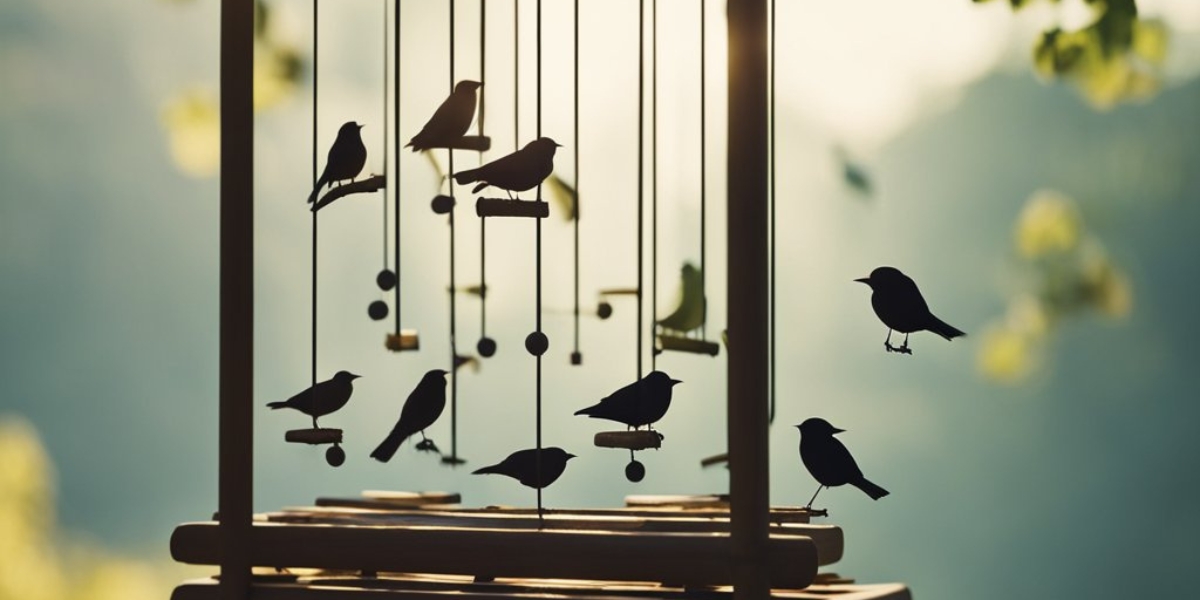Attracting birds to your yard or garden can be an incredibly rewarding experience. Listening to beautiful birdsong and observing wild birds up close provides relaxation, entertainment, and opportunities for nature photography and birdwatching. Using sounds is one of the most effective ways to attract different bird species to your surroundings. Read on to learn all about using bird sounds and calls to bring more birds to your home.
An Overview of Attracting Birds with Sound
Birds rely heavily on auditory communication. Their songs, calls, and alarms serve many important purposes, like defending territories, attracting mates, bonding with flock mates, and warning each other of danger. Mimicking these bird noises can convince wild birds that an area is safe and inhabited by their own species. This draws them in closer to investigate the sounds. With the right technique, you can use sound playback to shift birds’ attention in your direction and bring many desirable species into your yard or garden.
Attracting birds using sounds has many benefits:
- It provides a natural, non-disruptive method for birdwatching and nature photography.
- You can target specific species by playing their unique calls.
- It helps attract migrating and nesting birds to your yard.
- The increased bird activity helps control pests and pollinate plants.
- Listening to lively birdsong creates a peaceful ambiance to enjoy.
The keys are using proper bird call recordings, ideal speaker placement, and understanding when birds are most vocal and responsive to sound. Continue reading for more detailed guidelines on how to use sounds effectively to attract your favorite wild birds.
The Most Effective Bird Sounds and Calls
Different species are attracted to distinct songs, calls, alarms, and fledgling sounds. broadcasts their unique vocalizations to signal messaging to others of their own kind. Here are some of the most effective bird sounds to use to lure specific types of birds:
Mating and Territorial Calls
- American Robins – Cheerily carol “Cheer-up, cheer-ee, cheer-up, cheer-up.”
- Northern Cardinals – Loud, metallic “birdy birdy birdy” and high-pitched trills.
- Blue Jays – Harsh “jay jay” shrieks and gurgling notes.
- Chickadees – Namesake “chick-a-dee-dee” whistles and chatter.
- Northern Mockingbirds – Virtuosic song mimicry of other birds.
Feeding Calls
- Crows – Classic “caw caw” croaking.
- Sparrows – Distinctive chirping and short buzzes.
- Warblers – High, thin “seet” notes.
- Finches – Rollercoaster “br-zeee” calls.
Fledgling Begging Calls
- European Starlings – Rustic, squeaky twitters.
- House Sparrows – Loud, repetitive chirping.
- American Goldfinches – Persistent, musical tones.
- Barn Swallows – Raspy twitters.
Owl Hoots
- Eastern Screech Owl – Bouncing, tremolo hoots.
- Barred Owl – Distinct “who cooks for you” calls.
- Great Horned Owl – Deep “hoo hoo hooooo” hoots.
Hawk Cries
- Red-Tailed Hawk – Piercing, raspy screams.
- Northern Harrier – High-pitched squeals.
- American Kestrel – Rapid killy-killy-killy alarm calls.
The best results come from using high-fidelity recordings of actual birds vocalizing in nature rather than artificial sounds. Search for recordings of bird species native to your area during peak breeding and migration seasons. This rouses their instinctive territorial response and sexual attraction during times when they are most vocal.
Optimal Sound Playback Techniques
To maximize the bird-attraction power of your sound system, follow these tips on proper placement and operation:
Speaker Placement
Mount external speakers high up on trees or posts facing outwards to project sound over a wide area. Try to create a stereo effect with left and right speakers at slightly different heights and angles to mimic natural bird chatter. Keep speakers away from noisy machinery or roads to avoid scaring off birds.
For enclosed spaces like screened porches, place multiple small portable Bluetooth speakers in strategic spots hidden amongst the vegetation. Keep the volume moderate to avoid an abrasive, unnatural noise level.
Broadcasting Schedule
Birds are most energetic and vocal in the mornings and evenings. Schedule your playback during peak activity periods around dawn and dusk for best results. Play recordings on a randomized loop at varied intervals to create an authentic sense that different birds are calling.
Start off with short 15-30 minute sound sessions a few times per day, then gradually increase to an hour or two of intermittent playback during prime morning and evening activity periods. This prevents oversaturation while still attracting the most birds during their active hours.
Sound Variety and Changing Locations
Rotate through a diverse playlist of bird calls so it doesn’t become repetitive. Introduce new species vocalizations over time to keep attracting different birds. Occasionally move speakers to different spots or hang multiple units to generate curiosity over where sounds are originating from. This prevents habituation and keeps birds investigating the area longer.
Environmental Enhancements
Creating proper habitat and resources will exponentially enhance results. Provide food sources liked by your target species with feeders, fruiting shrubs, nut trees, and flowering plants that attract insects. Include dense brush, evergreens, and mature trees for shelter, nesting, and perching. Add a small pond or fountain for fresh water. Eliminate pesticides and artificial noise that could disturb visiting birds.
Using Actual Bird Sounds vs. Electronic Calls
Should you use recordings of real bird vocalizations or artificially-generated bird call devices? Both can attract birds under the right circumstances but have pros and cons to consider.
Benefits of Actual Bird Sound Recordings
- More authentic sounding with natural variation
- Can incorporate many species into one soundtrack
- Easier to download and play through Bluetooth speakers
- Less repetitive and habit-forming for birds
- Lower-cost option
Downsides of Bird Sound Recordings
- Audio quality varies based on source recording
- Cannot change or customize sounds
- Requires power source for outdoor speakers
- Can attract unwanted pest bird species
Benefits of Electronic Bird Callers
- Consistent, clear sounds with volume control
- Custom programming of specific species and songs
- Compact and portable
- No external power required
- Some models allow calls to be triggered by motion sensors
Downsides of Electronic Bird Callers
- More artificial, mechanical-sounding
- Limited to the programmed calling options
- Call sequences quickly become predictable
- Higher cost for programmable models
- Can attract birds unnaturally close to device location
In most cases, using high-quality recordings of bird vocalizations is the better option for attracting a diversity of wild birds in a natural way. But simpler electronic calls may work well for targeting a very specific species. Use programmed calls sparingly to avoid habituation.
Bird Sounds for Different Settings and Purposes
Certain bird sounds work especially well to attract species for specific settings and interests:
Backyard Birdwatching
Attract colorful, lively songbirds to your backyard with mixes of chickadees, titmice, nuthatches, warblers, sparrows, and finches. Mimic territorial birds squabble and dissent by playing overlapping calls of multiple species at once.
Rotate daily between mating, contact, juvenile, and alarm calls relevant to your area. Enhance the habitat with ample cover, feeders, and birdhouses to keep visitors active and engaged.
Bird Photography
Target the unique calls of regional specialties like orioles, tanagers, and buntings during breeding season. Use directional speakers to draw species into prime photo spots.
Set up perches and leave openings in planting areas for clear sightlines. Draw birds up higher with canopy species vocalizations for open, eye-level portraits.
Garden Birdscaping
Invite birds that help control garden pests and pollinate plants with sounds tailored to species like chickadees, nuthatches, woodpeckers, and phoebes.
Mimic nesting pairs are due to attract breeding birds that will return annually. Ensure good sightlines for monitoring activity and plenty of flowers, fruit shrubs, and cover for visitors.
Birdwatching Walks
Enhance guided birdwatching trips by using Bluetooth speakers along choice trails and overlooks. Schedule relevant vocalizations coinciding with migrations or breeding behaviors of target species.
Research peak activity periods for local specialties and time sound playbacks accordingly. Quietly observe reactions and allow photographers chances at prime shots of birds responding to calls.
Backyard Pondscapes
Entice colorful aquatic birds like kingfishers and waterfowl into a backyard pond habitat. Use speakers carefully camouflaged in shoreline vegetation to broadcast the peeping of ducklings and goslings searching for their mothers. Add the calls of dabbling ducks and the rattling cries of belted kingfishers.
Provide ample shoreline cover and perching spots to draw in investigating birds. Include some open areas for safe water access and unobstructed sightlines across the water. Maintain clean water quality and aquatic vegetation that birds depend on.
Playback Tips for Maximum Impact
Follow these techniques to enhance the effectiveness of your sound strategies:
Choose Clear, High-Quality Recordings
Well-recorded vocalizations in the natural habitat of each species work best. Search reputable birding sites and nature sound retailers for commercial compilations or actual birding recordings. Pick files with realistic fidelity, free of distracting background noise.
Use Intermittent, Overlapping Playback
Resist overplaying long, continuous recordings. Use abbreviated clips of 10-30 seconds each. Allow some silence between playbacks and mix species together like real bird-dawn choruses. Automated randomization systems help prevent repetitive patterns.
Follow Seasonal Activity Cycles
Research peak mating, migrating, and nesting times for your target birds. Tailor your playback to seasonal behaviors for the best response. For example, owls are most vocal in late winter; warblers and orioles during spring migration.
Start and End Slowly
Gradually increase playback duration over the first week or two. This prevents overstimulation and habituation. Likewise, slowly reduce the frequency of sound broadcasting at the end of each use cycle to ease birds back to their natural rhythms.
Maintain Inviting Habitat
Good shelter, food sources, water features, and nest sites are vital for prolonged bird activity. Make landscape improvements first before employing sounds so habitat needs are fully met for attracted species. Ongoing habitat enrichment and protection ensure recurring visits.
People Also Read:
- Why is Bird Poop Good Luck?
- How to Attract Birds with Sounds?
- How to Attract Birds to Your House: The Complete Guide
Conclusion
Using bird sounds can be an extremely effective technique for attracting wild birds to your surroundings. Mimicking the diverse vocalizations that different species use to communicate offers a natural way to draw them in by appealing to their instincts. Follow the tips outlined here regarding choosing the best calls, optimal sound broadcasting, equipment placement, and habitat enhancement for the best results. Be patient, observant of reactions, and willing to tweak your methods until you achieve maximum bird attraction. The increased activity will be rewarding!

